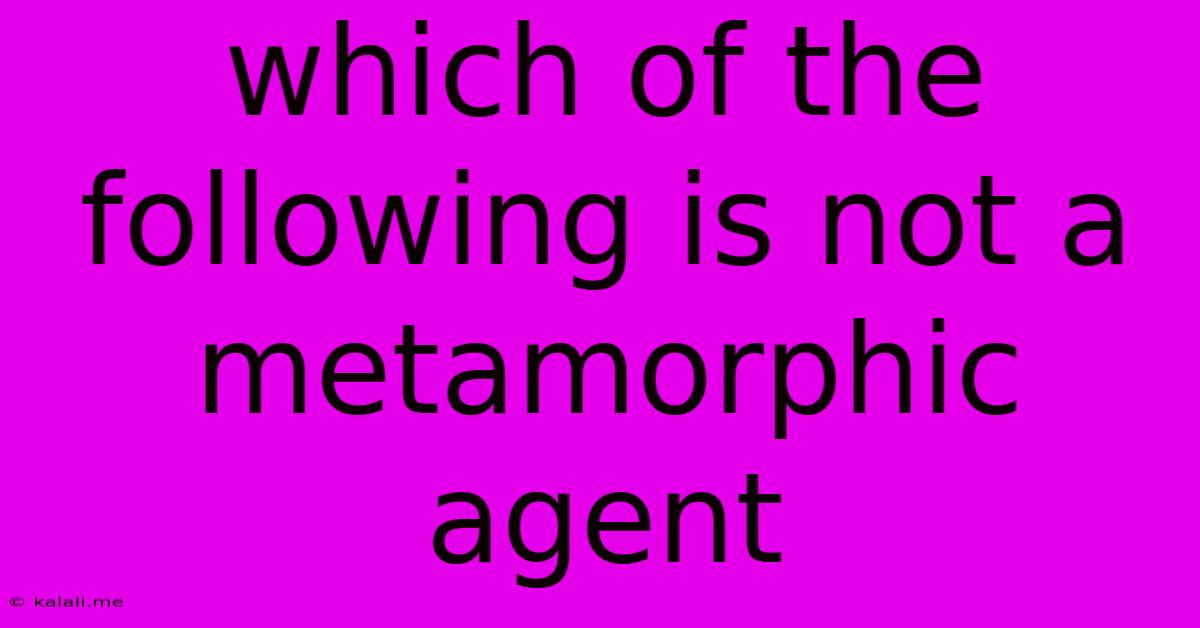Which Of The Following Is Not A Metamorphic Agent
Kalali
Jun 15, 2025 · 3 min read

Table of Contents
Which of the Following is NOT a Metamorphic Agent? Understanding the Processes that Change Rocks
Metamorphism, the transformation of existing rocks into new types without melting, is a fascinating geological process. It's driven by several powerful forces, known as metamorphic agents. Understanding these agents is key to comprehending the diverse range of metamorphic rocks found across the Earth. This article will explore the primary metamorphic agents and clarify which factor doesn't contribute to this transformative process. The key to understanding metamorphic rock formation lies in grasping the forces that reshape existing rock structures and mineral compositions.
What are Metamorphic Agents?
Metamorphic agents are the factors responsible for the changes that occur during metamorphism. These agents work individually or in combination to alter the texture, mineral composition, and overall structure of rocks. The primary metamorphic agents include:
-
Heat: Increased temperature significantly alters the crystal structure and mineral composition of rocks. High temperatures can cause recrystallization, where existing minerals rearrange to form larger crystals, or even the formation of entirely new minerals. This is often associated with proximity to magma intrusions or deep burial within the Earth's crust.
-
Pressure: Pressure, both directed (differential stress) and confining (uniform pressure), plays a crucial role in metamorphism. Differential stress, where pressure is applied unevenly, can cause rocks to fold and deform, while confining pressure compresses rocks, leading to changes in density and mineral arrangement. This pressure is especially significant in mountain-building processes and subduction zones.
-
Chemically Active Fluids: Water, along with other fluids carrying dissolved minerals, acts as a catalyst in metamorphic reactions. These fluids facilitate the exchange of ions between minerals, leading to the formation of new minerals and changes in the rock's chemical composition. These fluids can originate from pore water within sediments or be released during dehydration reactions at higher temperatures.
The Outsider: Which is NOT a Metamorphic Agent?
Now, let's consider a factor often mentioned in geology but doesn't directly cause metamorphism: Erosion. Erosion is the process of wearing away and transporting rock material through natural forces like wind, water, and ice. While erosion can expose metamorphic rocks to the surface, it does not contribute to their formation. Erosion is a destructive process, breaking down rocks rather than transforming them. It's a crucial part of the rock cycle, but separate from the metamorphic processes themselves.
Understanding the Rock Cycle's Interplay
It's important to understand that the rock cycle is a continuous process, with metamorphism often acting as a link between igneous, sedimentary, and other metamorphic rocks. Erosion plays a vital role in exposing metamorphic rocks formed deep within the Earth, making them accessible for study. However, its role is distinct from the transformative forces of heat, pressure, and chemically active fluids.
In Conclusion:
While erosion is an important geological process, it is not a metamorphic agent. Heat, pressure, and chemically active fluids are the primary factors that drive the transformation of rocks through metamorphism, creating the diverse range of metamorphic rock types we observe in the Earth's crust. Understanding the distinction between erosion and metamorphic agents is essential for comprehending the complex and fascinating processes that shape our planet's geology.
Latest Posts
Latest Posts
-
2500 In Words For A Check
Jun 15, 2025
-
A Positive Ion Is Known As A
Jun 15, 2025
-
A Sample Of Professors Is Selected And It Is Found
Jun 15, 2025
-
How Many Valence Electrons Does O2 Have
Jun 15, 2025
-
Ca Oh 2 Acidic Or Basic
Jun 15, 2025
Related Post
Thank you for visiting our website which covers about Which Of The Following Is Not A Metamorphic Agent . We hope the information provided has been useful to you. Feel free to contact us if you have any questions or need further assistance. See you next time and don't miss to bookmark.